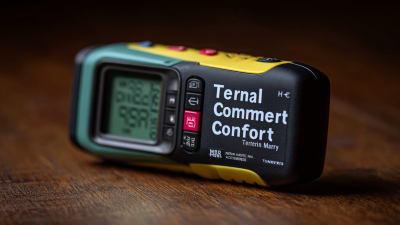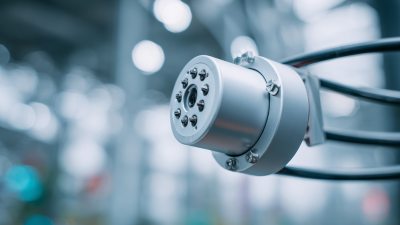
-
Home
-
Product Center
-
Application
-
Support
-
JT Cloud
-
About Us
-
Contact Us
Leave Your Message

Creating a living space that successfully promotes comfort is essential for enhancing our day-to-day experiences. "Measuring Comfort Levels" is a fundamental undertaking as it allows us to identify which aspects of our environment contribute to our overall well-being. From indoor temperature and lighting to furniture arrangement and personal decor, various factors influence how comfortable we feel in our surroundings. By assessing these elements, we can make informed decisions that lead to the creation of a more inviting and enjoyable living space.

In this guide, we will explore the top ten effective ways to measure comfort levels in your home or workspace. These strategies will not only help you recognize areas that may require improvement but also offer practical tips for implementing changes that align with your unique preferences and needs. With the right measurement tools and approaches, you can transform your living environment into a sanctuary that fosters relaxation, productivity, and a sense of belonging. Join us as we delve into these essential methods for elevating your comfort levels and ultimately enhancing your living experience.
In the quest for enhanced living spaces, innovative technologies play a transformative role in measuring comfort levels in real time. Modern households are increasingly equipped with smart sensors that track temperature, humidity, air quality, and noise levels, providing residents with valuable data at their fingertips. These sensors can be integrated into mobile applications, allowing users to monitor and adjust their home environments instantaneously. For instance, smart thermostats utilize algorithms to learn occupants' preferences and optimize heating and cooling systems, ensuring an ideal climate for productivity and relaxation.
Furthermore, wearable technology has emerged as a significant contributor to comfort measurement. Devices like smartwatches and fitness bands can monitor physiological responses, such as heart rate and stress levels, and suggest adjustments to the home environment based on this data. By combining these insights with home automation systems, users can create personalized living experiences that enhance well-being. This real-time interaction signals a shift towards a more responsive and comfortable home environment, ultimately leading to better quality of life for residents.
Ambient sensors play a crucial role in measuring and enhancing comfort levels within living spaces by providing real-time data on various environmental factors. These sensors can assess indoor air quality by monitoring levels of pollutants such as carbon dioxide, volatile organic compounds (VOCs), and particulate matter. By collecting this information, homeowners can make informed decisions about ventilation and air purification, ensuring a healthier living environment. The integration of smart technology in these sensors allows for automatic adjustments, improving both comfort and well-being.
In addition to air quality, ambient sensors also track temperature, humidity, and light levels, which are critical for maintaining an optimal indoor atmosphere. By analyzing this data, these sensors can help create conditions tailored to individual preferences, thereby enhancing overall comfort. For instance, by adjusting HVAC systems based on real-time feedback, energy efficiency is improved while simultaneously ensuring that living spaces remain inviting and accommodating. The role of ambient sensors in home environments signifies a shift towards a more responsive and personalized approach to residential comfort.
In the quest for enhanced living spaces, personalizing comfort levels is crucial to creating environments that cater to individual preferences. User-centric approaches emphasize the importance of understanding the diverse needs of occupants. This can be achieved through methods such as surveys and interviews, allowing residents to express their comfort requirements regarding temperature, lighting, and acoustics. By collecting this data, designers and architects can tailor spaces to fit the specific desires of users, transforming generic areas into welcoming havens.

Another effective strategy involves the integration of technology, such as smart home systems, which adapt to users' habits and preferences. For instance, smart thermostats learn a person's temperature preferences over time, modifying settings automatically to ensure optimal comfort. Additionally, lighting systems can be customized to adjust throughout the day, enhancing mood and well-being. By embracing these innovative solutions, living spaces can be dynamically personalized, ensuring that every individual feels at home. Ultimately, user-centric approaches not only enhance comfort but also foster a deeper connection between individuals and their environments.
When designing living spaces, the psychological factors that influence perceived comfort play a crucial role. Comfort is not solely defined by physical attributes like furniture and lighting; it is deeply intertwined with our emotional responses to our environment. Elements such as colors, textures, and spatial arrangements can evoke feelings of safety, warmth, or even anxiety. Understanding these factors can help create spaces that promote well-being.
To enhance comfort levels, consider incorporating natural elements into your designs. Biophilic design, which includes plants and natural light, has been shown to reduce stress and improve mood. Pay attention to color psychology as well; warm hues can create a sense of coziness while cool tones may inspire tranquility.
Additionally, the arrangement of furniture can significantly affect how a space feels. Creating intimate seating arrangements encourages conversation and connection, while open layouts promote a sense of freedom and movement. Remember that design should cater to both personal preferences and the psychological impacts of the space, maximizing comfort for everyone who enters.
In today's quest for enhanced living environments, assessing comfort levels has evolved significantly from traditional methods to modern, data-driven techniques. Traditional assessments often relied on subjective measures like personal surveys and observations, leading to potential biases. A report by the American Society of Interior Designers indicates that 65% of professionals prefer quantitative methods over qualitative ones, emphasizing the shift toward more objective criteria in evaluating comfort.
Modern approaches now incorporate technology such as environmental sensors and software analytics to measure variables like temperature, humidity, and light levels in real time. Research from the International Journal of Architectural Engineering and Design suggests that optimized indoor climates can improve productivity by up to 25%. Furthermore, integrating user feedback through mobile applications allows for a dynamic understanding of comfort, enabling more personalized adjustments that were previously unattainable with conventional methods. This comparative analysis highlights how leveraging data analytics not only refines comfort assessment but also enhances occupant well-being and satisfaction in living spaces.






